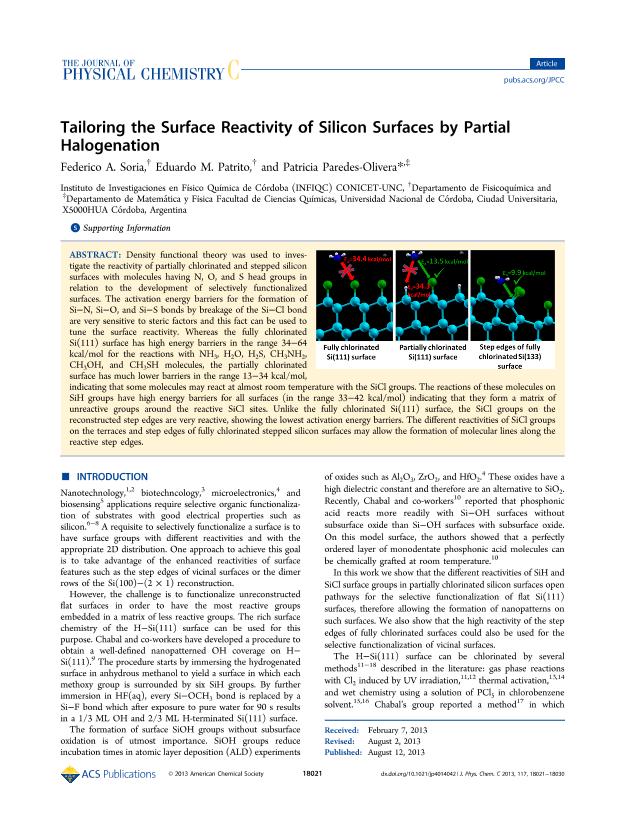Mostrar el registro sencillo del ítem
dc.contributor.author
Soria, Federico Ariel

dc.contributor.author
Patrito, Eduardo Martin

dc.contributor.author
Paredes Olivera, Patricia

dc.date.available
2017-10-04T13:32:08Z
dc.date.issued
2013-08
dc.identifier.citation
Soria, Federico Ariel; Patrito, Eduardo Martin; Paredes Olivera, Patricia; Tailoring the surface reactivity of silicon surfaces by partial halogenation; American Chemical Society; Journal of Physical Chemistry C; 117; 35; 8-2013; 18021-18030
dc.identifier.issn
1932-7447
dc.identifier.uri
http://hdl.handle.net/11336/25838
dc.description.abstract
Density functional theory was used to investigate the reactivity of partially chlorinated and stepped silicon surfaces with molecules having N, O, and S head groups in relation to the development of selectively functionalized surfaces. The activation energy barriers for the formation of Si–N, Si–O, and Si–S bonds by breakage of the Si–Cl bond are very sensitive to steric factors and this fact can be used to tune the surface reactivity. Whereas the fully chlorinated Si(111) surface has high energy barriers in the range 34–64 kcal/mol for the reactions with NH3, H2O, H2S, CH3NH2, CH3OH, and CH3SH molecules, the partially chlorinated surface has much lower barriers in the range 13–34 kcal/mol, indicating that some molecules may react at almost room temperature with the SiCl groups. The reactions of these molecules on SiH groups have high energy barriers for all surfaces (in the range 33–42 kcal/mol) indicating that they form a matrix of unreactive groups around the reactive SiCl sites. Unlike the fully chlorinated Si(111) surface, the SiCl groups on the reconstructed step edges are very reactive, showing the lowest activation energy barriers. The different reactivities of SiCl groups on the terraces and step edges of fully chlorinated stepped silicon surfaces may allow the formation of molecular lines along the reactive step edges.
dc.format
application/pdf
dc.language.iso
eng
dc.publisher
American Chemical Society

dc.rights
info:eu-repo/semantics/openAccess
dc.rights.uri
https://creativecommons.org/licenses/by-nc-sa/2.5/ar/
dc.subject
Functionalized Surfaces
dc.subject
Silicon Surfaces
dc.subject
Surface Reactivity
dc.subject.classification
Otras Ciencias Químicas

dc.subject.classification
Ciencias Químicas

dc.subject.classification
CIENCIAS NATURALES Y EXACTAS

dc.title
Tailoring the surface reactivity of silicon surfaces by partial halogenation
dc.type
info:eu-repo/semantics/article
dc.type
info:ar-repo/semantics/artículo
dc.type
info:eu-repo/semantics/publishedVersion
dc.date.updated
2017-10-03T18:24:34Z
dc.journal.volume
117
dc.journal.number
35
dc.journal.pagination
18021-18030
dc.journal.pais
Estados Unidos

dc.journal.ciudad
Washington DC
dc.description.fil
Fil: Soria, Federico Ariel. Consejo Nacional de Investigaciones Científicas y Técnicas. Centro Científico Tecnológico Conicet - Córdoba. Instituto de Investigaciones en Físico-química de Córdoba. Universidad Nacional de Córdoba. Facultad de Ciencias Químicas. Instituto de Investigaciones en Físico-química de Córdoba; Argentina
dc.description.fil
Fil: Patrito, Eduardo Martin. Consejo Nacional de Investigaciones Científicas y Técnicas. Centro Científico Tecnológico Conicet - Córdoba. Instituto de Investigaciones en Físico-química de Córdoba. Universidad Nacional de Córdoba. Facultad de Ciencias Químicas. Instituto de Investigaciones en Físico-química de Córdoba; Argentina
dc.description.fil
Fil: Paredes Olivera, Patricia. Universidad Nacional de Córdoba. Facultad de Ciencias Químicas; Argentina. Consejo Nacional de Investigaciones Científicas y Técnicas; Argentina
dc.journal.title
Journal of Physical Chemistry C

dc.relation.alternativeid
info:eu-repo/semantics/altIdentifier/doi/http://dx.doi.org/10.1021/jp4014042
dc.relation.alternativeid
info:eu-repo/semantics/altIdentifier/url/http://pubs.acs.org/doi/abs/10.1021/jp4014042
Archivos asociados
